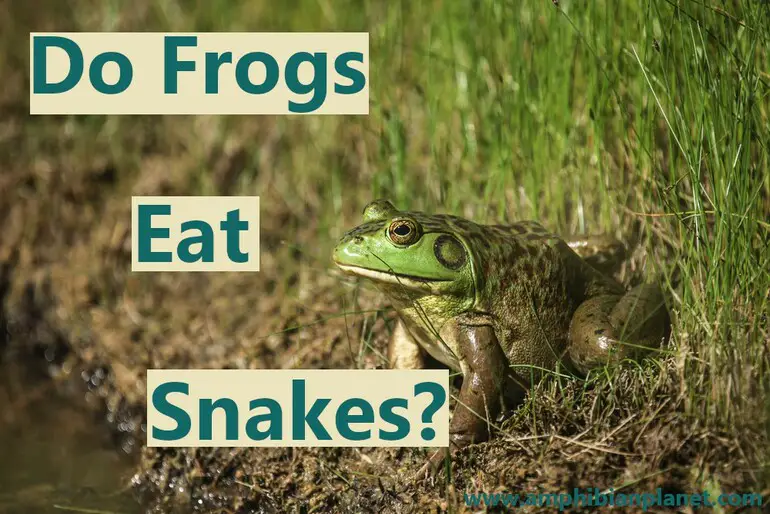Frogs are aggressive predators that aren’t picky with what they eat. Different frog species can eat slightly different things, mainly based on their size and the environment they live in. In general, the bigger the frog, the bigger the prey it can eat. But do frogs eat snakes?
In general, frogs eat snakes that are small enough to fit in their mouths. Large species of frogs (such as bullfrogs) eat small or juvenile snakes. Smaller frogs do not typically eat snakes because they are too large to fit into their mouths. Frogs that eat snakes prefer to eat non-venomous snakes, but occasionally eat venomous ones.
Frogs are generalist carnivores and will eat almost any prey they can catch, overpower, and fit into their mouths.
Large, and Some Medium-Sized Frogs Eat Small Snakes
Large frog species such as bullfrogs and Pacman frogs eat small snakes. As mentioned above, they generally prefer to eat non-venomous snakes but this does not mean that they will not attempt to eat venomous snakes too.
That being said, it is important to note that snakes will not be the first choice of meal for most frogs. They will eat snakes when the opportunity presents itself, but will not purposely seek out snakes to prey on.
Below is a list of frog species that are known to eat snakes:
- American bullfrog
- African bullfrog
- East Asian bullfrog
- Indian bullfrog
- Leopard frog
- Pickerel frog
- Australian Green Tree Frog
- Pacman frog
- Cane toad
- Goliath frog
- Robust spadefoot toad
Smaller frog species such as gray tree frogs do eat snakes because they are not large enough to overpower or swallow the majority of snake species. Instead, these frogs are very often eaten by snakes.
Bullfrogs Eat Snakes
Bullfrogs will eat almost anything that passes in front of them – as long as they can fit it into their mouths. They will eat scorpions, spiders, rodents, bats, fish, birds, lizards, and even each other! (yes, they can be cannibals).
If a snake passes in front of a hungry bullfrog, the frog will try to eat it.

The exact type of snake most frequently eaten by bullfrogs will vary depending on their bullfrog species, and the environment where those bullfrogs live.
For example, the most common snake American bullfrogs may try to eat is a juvenile garter snake. These snakes are often common in the range of the American bullfrog, and the young ones are small enough for adult American bullfrogs to eat.
African and Asian bullfrogs will eat small snakes available in their respective environments.
However, like all frogs, bullfrogs may try to eat prey that is too large for them. For this reason, they often bite and try to eat snakes that are too large for them.
Australian Green Tree Frogs Eat Snakes
Another frog that is known to eat snakes is the Australian green tree frog (also called the ‘White’s tree frogs’). These frogs are fairly small, only growing to a maximum length of 4.5 inches as adults. But this does not stop them from eating snakes when they get the chance.
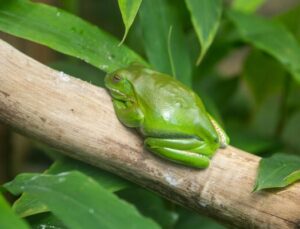
Due to their small size, they mainly eat very young snakes that they can easily swallow. They mainly eat non-venomous snakes such as the common keelback (a small non-venous snake found in Australia).
However, they have also been documented eating venomous red-bellied black snakes, and even Coastal Taipan Snakes – which are the third third-most venomous terrestrial snakes in the world!
Female Australian green frogs are larger than males, so they can eat larger snakes than the latter.
Pacman Frogs Eat Snakes
Pacman frogs (Argentine horned frogs) grow to a length of six inches and are about as wide as they are long. They have very large mouths, enabling them to large prey such as snakes.

Pacman frogs typically eat juvenile non-venomous snakes.
Cane Toads Eat Snakes
Cane toads (also called marine toads) are the largest toads in the world. They typically grow about 4 -6 inches in length, but can grow to over 9 inches in length and weigh over one pound!
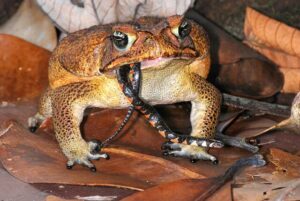
This large size allows cane toads to eat large prey such as bats, rodents, birds, and small reptiles. If a small enough snake passes in front of a cane hungry toad, the toad will eat it.
Other Frogs That Eat Snakes
Other frogs that are known to eat snakes are Leopard frogs, Pickerel frogs, Goliath frogs, and Robust spadefoot toads.
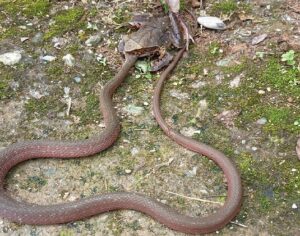
Frogs are not selective eaters, so they will eat almost any prey can catch and swallow. As a general rule, most large terrestrial frog species will eat a snake when given the chance.
Do Frogs Get Bitten When They Eat Snakes?
When a frog eats a snake, it bites to keep it from moving away, then swallows it alive and whole. Very often, the snake is swallowed tail first, which gives it enough time and room to wriggle and bite the frog.
Frogs often get bitten multiple times when they eat snakes. A snake can bite even when most of its body has already been swallowed by the frog (as long as its head is still sticking out of the frog’s mouth).
Sometimes, a snake can even bite a frog’s tongue, mouth, and throat as it is being swallowed.
Some Frogs May Be Immune to Snake Venom
Frogs usually eat non-venomous, or only mildly venomous snakes, so the bites from these snakes do not cause any serious harm.
However, as mentioned above, some frogs such as the Australian green tree frog can eat very highly venomous snakes, and often get bitten in the process.
American bullfrogs are known to be at least partially resistant to the venom of such snakes such as the copperhead and cottonmouth snakes.
However, there have not been scientific studies into the venom resistance of many species of frogs.
Still, there was an incident in which an Australian green tree frog ate a Coastal Taipan snake (the third most venomous terrestrial snake in the world) and survived despite being bitten multiple times
This incident (link to Facebook post) was shared on the “Townsville – Burdekin Chapel Pest Control & Snake Take Away” Facebook page.

While replying to the same post, the company further informed that after eating the snake, bite marks from the snake became apparent, but the frog was still alive and was functioning normally 5 days after the incident.
Although official scientific studies have not been done, this incident at least suggests that some frogs may be immune to snake venom, even from highly venomous snakes.
Large Snakes Eat Smaller Frogs
While large frogs can eat snakes, snakes also very frequently prey on frogs. In fact, in the majority of situations, the roles are actually reversed, ie the snake eats the frog.
Worldwide, many snakes primarily feed on small amphibians and rodents. For example, in North America, the primary food of the eastern hognose snake is toads.
In fact, Eastern hognose snakes are so specialized in eating toads, that they have large teeth in the back of their mouths to puncture inflated toads to make them easier to swallow.
Garter snakes are also heavily reliant on frogs, toads, salamanders, and newts as food. Asian Keelback snakes also very frequently eat frogs and their tadpoles.
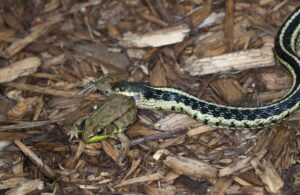
There are even snakes that specialize in eating frog egg masses laid on leaves on leaves overhanging streams.
Some Frogs Have Toxins to Stop Snakes (And Other Predators) From Eating Them
To stop snakes (and other predators from eating them), many newts, frogs, and toads can produce poisonous skin secretions that taste bad or are lethal to many predators.
Pickerel frogs, American toads (like all toads), and many other frog species produce poisonous skin secretions so many snakes will learn to leave them alone.
Still, even poisonous frogs are often eaten by some snake species. Northern water snakes and garter snakes have developed immunity to the secretions of pickerel frogs and are known to frequently eat these frogs.
Also, eastern hog-nosed snakes (and garter snakes) frequently eat highly poisonous toads with impunity, due to the resistance these snakes have to the toxins toads secrete.
A few snake species such as the knife-toothed kukri snakes have learned a way to avoid frog and toad poison altogether.
Since frogs and toads secrete their defensive toxins on their skin, these snakes have learned to eat the frog or toad’s insides, completely avoiding the poisonous sections on the skin.
Can Frogs Kill Snakes?
Large frogs kill snakes by catching them off guard and swallowing them alive, and whole. The snake gets wrapped up in the frog’s tacky tongue. Eventually, the snake can’t move and chokes in the frog’s stomach acids and dies.
However, most frogs are not large enough to kill snakes directly but rely on their toxins to do the job.
Many frogs such as the golden poison Dart Frog, Blue Poison Dart Frog, and many other poison frogs have extremely potent toxins that will kill any snake that eats them.
Toads have large parotid glands behind the eyes and warty glands on the skin that produce a milky poisonous fluid.
However, as mentioned above, some snakes have developed immunity to the poison toads produce – but large toads can produce enough poison to kill most snakes.
In Australia, the keelback snakes mainly prey on frogs and toads such as the cane toad. Due to this, keelback snakes have a genetic tolerance to the poison toads produce. But this only works on small toads.
Due to this, keelback snakes mainly eat small cane toads, – but sometimes, the snakes may try to eat toads that are too big. When this happens, the toad will release large amounts of poison that are too strong, even for the snake’s poison tolerance.
When the snake ingests this poison, it will let go of the toad before it even swallows it. If the snake swallows the toad, it may gag and regurgitate the amphibian, or sometimes even die due to the toad’s poison.
Can Captive Frogs Be Fed Snakes?
Most hobbyists don’t feed snakes to their frogs for three main reasons.
One, most frogs aren’t large enough to eat snakes. Usually, hobbyists prefer frogs that are smaller in size as compared to ones that are large such as bullfrogs or Pacman frogs.
Two, snakes can bite and even seriously injure a frog during feeding.
Three, it is somewhat impractical for hobbyists to feed snakes to their frogs. It’s usually cheaper, faster, and easier to feed insects and worms to amphibians.
Also, since frogs generally eat live prey, the “feeder snakes” would have to be kept alive for long periods before they are fed to the frog.
It makes little sense to feed snakes to captive frogs because there are cheaper and easier alternative prey items out there.
Still, captive bullfrogs, Pacman frogs, and other large frog species will eat snakes when they are offered.
Frequently Asked Questions (FAQS)
Can a Frog Eat a Snake? A frog can eat a snake if it is small enough to fit in the mouth and swallow. Bullfrogs and other large frog species frequently eat snakes they can catch.
What Kind of Frogs Eat Snakes? Frogs that eat snakes are the larger species such as Bullfrogs, and Pacman frogs (Argentine Horned Frogs). However, some smaller frog species such as the Australian green tree frog also frequently eat snakes.
Do Frogs Eat Small Snakes? Frogs eat almost any prey they can fit into their mouths. If a snake is small enough for a frog to swallow, the frog will probably try to eat it. Large frogs eat larger snakes, and small frogs eat smaller snakes.
Do frogs like eating snakes? Frogs only eat snakes opportunistically but do not seek out snakes to prey on. Snakes do not make up a large part of most frog’s diets.
Final Thoughts
Frogs are generalist predators that will eat almost any prey they can fit into their mouths. Larger frog species can eat snakes, however, they do not intentionally seek out snakes to prey on.
Rather, they only eat them opportunistically when they get the chance.

